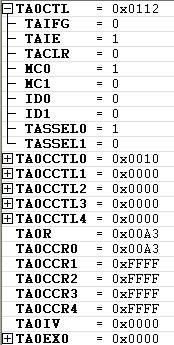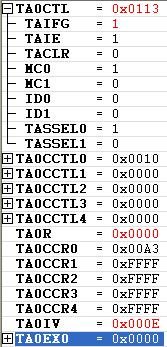我们使用的是 msp430f5310, 测试代码如下:
#include <msp430f5310.h>
#pragma vector=TIMER0_A0_VECTOR
__interrupt void timer0_A0_ISR(void)
{
TA0CTL &= ~TAIFG;
}
#pragma vector=TIMER0_A1_VECTOR
__interrupt void timer0_A1_ISR(void)
{
switch(__even_in_range(TA0IV, 14))
{
case 0:
break; // No interrupt
case 2:
break;
case 4:
break;
case 6:
break;
case 8:
break;
case 14: // overflow
break;
default:
break;
}
}
void main(void)
{
WDTCTL = WDTPW + WDTHOLD; // Stop watchdog timer
P5SEL |= BIT4+BIT5; // Select XT1
UCSCTL6 &= ~(XT1OFF); // XT1 On
UCSCTL6 |= XCAP_3; // Internal load cap
UCSCTL3 = 0; // FLL Reference Clock = XT1
// Loop until XT1,XT2 & DCO stabilizes - In this case loop until XT1 and DCo settle
do
{
UCSCTL7 &= ~(XT2OFFG + XT1LFOFFG + DCOFFG);
// Clear XT2,XT1,DCO fault flags
SFRIFG1 &= ~OFIFG; // Clear fault flags
}while (SFRIFG1&OFIFG); // Test oscillator fault flag
UCSCTL6 &= ~(XT1DRIVE_3); // Xtal is now stable, reduce drive strength
TA0CTL = TASSEL_1 | TACLR;
TA0CCR0 = 163;
TA0CCTL0 = CCIE;
TA0CTL = TASSEL_1 | MC_1 | TACLR | TAIE;
__bis_SR_register(LPM3_bits + GIE);
}
在上述的的测试代码下,调试时分别在上面的两个中断函数里面打断点,发现两个中断都会进去。
进 TIMER0_A0_VECTOR 中断时,寄存器值如下
进 TIMER0_A1_VECTOR 中断时,寄存器值如下
也就是,在 TA0R 被复位时,定时器会产生 Timer overflow 中断。对于这个 Timer overflow 中断感到不理解,因为这个中断处理会唤醒 CPU 进行处理中断操作,影响程序的功耗,应该怎么去屏蔽这个中断,禁止其生成中断,按照我的理解,这里是不应该产生中断的,因为定时器并没有产生溢出。请问该如何处理,才会不产生该 Timer overflow 中断,谢谢!


